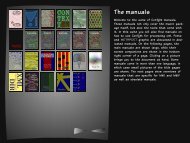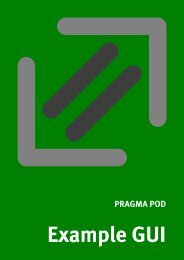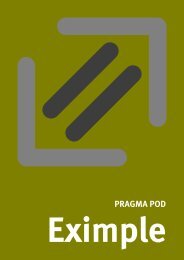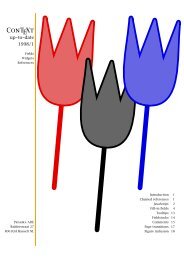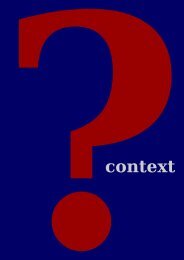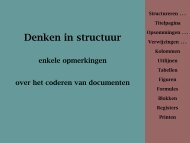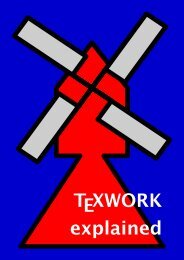The ConTEXt presentation styles - Pragma ADE
The ConTEXt presentation styles - Pragma ADE
The ConTEXt presentation styles - Pragma ADE
- No tags were found...
Create successful ePaper yourself
Turn your PDF publications into a flip-book with our unique Google optimized e-Paper software.
Columns may differ in width.Columns and GridsOverall AppearanceEmbedded GraphicsLayers in TextFirst of all we want our columnsto be perfectly balanced.This is trivial for pure text,but imagine lots of whitespace, like display math.We want floats to be moved tothe best available location. Ofcourse we want floats to spanmore than one column, andeven spanning one and a halvecolumn with a text flowing aroundthe figure should be possible.In double sided output, wewant lines to align on theopposing pages (spread). Whenwe hold the paper towardsa bright source of light, wewant the lines to align too.We definitely don’t want to end upwith a few lines or words on thelast page. Why not apply a smallpercentage of glyph scaling insuch a way that we get full pages?Of course we will need more thanparagraph and page optimizationfor this: we are dealing withthe document as a whole.Think of two columns, spanningone third and two thirds of apage. In the middle of suchtwo columns we will want totypeset an illustration, and thetext should follow the circularshape of this illustration.Do we need NTS?Columns and GridsColumns and GridsColumns and GridsColumns and GridsColumns and GridsTalking of illustrations,instead of being somethingwith fixed dimensions, thescale may be adapted, ofcourse consistently, to suit theoverall document appearance(grid, spread, and more).Are you still thinking from leftto right? Text can go in alldirections, and will be mixedtoo. <strong>The</strong> width of columnsmay change in the meantime.Anyone who has seen traditionaljewish religion documents, willsee the challenge in nestedA case study of columns.Typesetting is more thanmanipulating metrics. Don’twe need a typesetting systemthat looks at the glyphsthemselves, the small graphics?People tend to disagree on whatlooks best, but experts often agreeon what looks worse. Why notbuild in expert knowledge, oreven better, build a system thatlearns from the user’s rating?How is greyness calculated? Doesnts act upon the internal lists ofglyphs, or does it first build abitmap? At least then it knowshow the pages comes out. Is thevalidation a function of an outputcolumns with (foot)notesdevice? Will the shape of glyphsflowing around partial columns.depends on the rating? Will T E Xand METAFONT become one?Columns and GridsColumns and GridsColumns and GridsOverall AppearanceOverall AppearanceOverall AppearanceT E X is strong in math, but howIs, in validating the appearance,a model of the page needed, interms of meaningful areas? If so,how is such a model defined? Dowe need pattern recognition?nts needs a graphics engine, ormaybe even several. Models forexchange of information betweenprocesses dealing with puretypesetting and drawing shapesneed to be developed. Suchmechanisms should cooperatenaturally with the paragraphand page breaking as well.Typesetting along curves,turning shapes into outlines,and applying arbitrary fillingabout (bio)chemistry? Althoughsatisfactorily results can bereached, more is needed. Haven’twe all seen documents thatmade us wonder how to typesetthat in T E X? Lots of thinkingneeds to go into that area.For some languages pastingtogether glyphs is not enough.Actually drawing glyphs, or evenbetter: words or sentences can bean alternative. Even emotions canmake it into typeset text. Stronghandwriting oriented graphicshas to meet expressive coding.Some examples ofembedding graphics.and shading, it all makes sense.Overall AppearanceEmbedded GraphicsEmbedded GraphicsEmbedded GraphicsEmbedded GraphicsEmbedded GraphicsFirst of all, the new systemneeds some more understandingabout the typeset text.Support for Unicode, unifiedglyph names is mandate.When searching through adocument, some knowlegde onwhat in language the text we’redealing with makes sense. Notonly the (many) language(s) of atext, but the direction also playsa role. Complicated ligaturesshould be recognized properly.In more dynamic documents,like fill--in--forms, interactionwith a typesetting engine is not aluxury, especially not in europeanand eastern languages. ntscan be such a plug in, but thedocument itself should containthe information needed to let ntsto do its task. A document ismore than a collection of graphicsand glyphs, and typesettingmore than organizing those.As pdfT E X already demonstrates,using T E X to embed typesetinformation like pop--up--help andtool tips is a breeze. Althoughheavily dependent of features ofviewers, nts will benefit from adecent model of layers on whichwe typeset as well as conceptsof information hidden in theoutput but showing up at wish.Layers in TextLayers in TextLayers in TextLayers in Textspider / pre-07contentsquit





